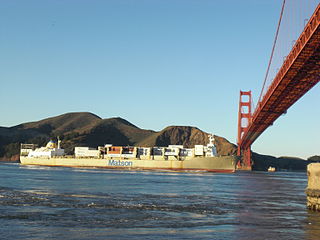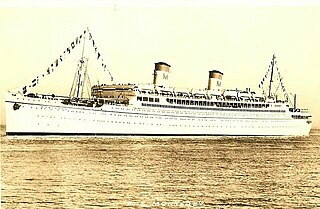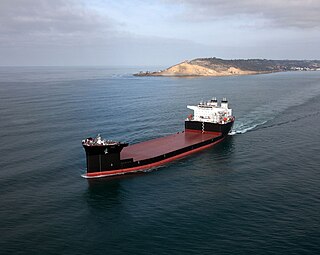Related Research Articles

Hawaii is a U.S. state that is an archipelago in the Pacific Ocean. Of the eight major islands, Hawaii, Oʻahu, Maui, and Kauaʻi have major tourism industries, while it is limited on Molokai and Lānaʻi and access to Niihau and Kahoʻolawe is restricted.

Matson, Inc. is an American shipping and navigation services company headquartered in Honolulu, Hawaii. Founded in 1882, Matson, Inc.'s subsidiary Matson Navigation Company provides ocean shipping services across the Pacific to Hawaii, Alaska, Guam, Micronesia, the South Pacific, China, and Japan.
A cargo ship or freighter is a merchant ship that carries cargo, goods, and materials from one port to another. Thousands of cargo carriers ply the world's seas and oceans each year, handling the bulk of international trade. Cargo ships are usually specially designed for the task, often being equipped with cranes and other mechanisms to load and unload, and come in all sizes. Today, they are almost always built of welded steel, and with some exceptions generally have a life expectancy of 25 to 30 years before being scrapped.

National Steel and Shipbuilding Company, commonly referred to as NASSCO, is an American shipbuilding company with three shipyards located in San Diego, Norfolk and Mayport. It is a division of General Dynamics. The San Diego shipyard specializes in constructing commercial cargo ships and auxiliary vessels for the US Navy and Military Sealift Command; it is the only new-construction shipyard on the West Coast of the United States. The Virginia shipyard primarily performs ship repairs and conversions for the United States Navy.

Philly Shipyard, formerly Aker Philadelphia Shipyard, is a commercial shipyard located in Philadelphia, Pennsylvania, United States on part of the site of the Philadelphia Naval Shipyard. The commercial yard began after the United States Navy had ended most of its operations at the site.

Ferguson Marine Limited is a shipbuilding company whose yard, located in Port Glasgow on the Firth of Clyde in Scotland, was established in 1903. It is the last remaining shipbuilder on the lower Clyde and is currently the only builder of merchant ships on the river. For some years the company's mainstay has been Roll-on/roll-off ferries, primarily for Caledonian MacBrayne (CalMac), including a series of innovative hybrid diesel-electric/battery-powered vessels. Beset with difficulties since 2018 over their latest two CalMac ferries, Fergusons' largest ever vessels, the shipyard has been owned by the Scottish Government since December 2019.
SS Malolo was a passenger liner and cruise ship built by William Cramp & Sons, Philadelphia, in 1926 for the Matson Line. She was the first of a number of ships designed by William Francis Gibbs for the line, which did much to develop tourism in the Hawaiian Islands. In 1927, Matson commissioned its largest ship yet, the Malolo for the first-class luxury service between San Francisco, Los Angeles, and Honolulu. The Malolo and other Matson liners advertised superb public rooms, spacious cabins, swimming pools, a gymnasium, and a staff, including a hairdresser, to provide a high standard of service.

SSLurline was the third Matson Lines vessel to hold that name and the last of four fast and luxurious ocean liners that Matson built for the Hawaii and Australasia runs from the West Coast of the United States. Lurline's sister ships were SS Malolo, SS Mariposa and SS Monterey. Lurline served as a troopship in World War II operated by War Shipping Administration agents serving Army troop transport requirements.

SS Monterey was a luxury ocean liner launched on 10 October 1931. The ship was completed April 1932 and is shown in registers as a 1932 ship. Monterey was the third of the four ships of the Matson Lines "White Fleet", which were designed by William Francis Gibbs and also included SS Malolo, SS Mariposa and SS Lurline. Monterey was identical to Mariposa and very similar to Lurline. During World War II Monterey was used as a troopship operated by Matson as agents of the War Shipping Administration (WSA). Monterey was a large, fast transport capable of sailing independently and was allocated to serving Army troop transport requirements. The ship was involved in an attack on a convoy near Cape Bougaroun.

USNS Medgar Evers (T-AKE-13) is a Lewis and Clark-class dry cargo ship of the United States Navy. As part of the Navy's Combat Logistics Force, her mission is to deliver ammunition, provisions, dry stores, refrigerated food, spare parts, potable water, and diesel and jet fuel to U.S. Navy and allied ships while at sea. The ship is named for civil rights activist Medgar Evers, a World War II veteran who was assassinated in 1963. The Navy announced the naming on 9 October 2009.

An Expeditionary Transfer Dock (ESD), formerly the Mobile Landing Platform (MLP), is designed to be a semi-submersible, flexible, modular platform providing the US Navy with the capability to perform large-scale logistics movements such as the transfer of vehicles and equipment from sea to shore. These ships significantly reduce the dependency on foreign ports and provide support in the absence of port availability. The class also houses a sub-class variant called the Expeditionary Mobile Base (ESB), formerly the Afloat Forward Staging Base (AFSB).

USNS Montford Point (T-ESD-1),, the lead ship of her class of Expeditionary Transfer Docks (ESD), is a ship named in honor of African American Marine Corps recruits who trained at Montford Point Camp, North Carolina, from 1942 to 1949. After $115 million was allocated for long-lead time material and advanced design efforts, in late 2010 General Dynamics's National Steel and Shipbuilding Company was awarded the contract, worth approximately $500 million, to build the first of three planned vessels.
The Type C7 ship(Lancer Class) is a United States Maritime Administration (MARAD) designation for a cargo ship and the first US purpose-built container ship. The vessels were constructed in US shipyards and entered service starting in 1968. As US-built ships they were Jones Act qualified for shipments between US domestic ports. Under the Jones Act domestic US maritime trade is restricted to US-built and flagged vessels of US owners and manned by predominantly US-citizen crews. The last active Lancer container-configured ship was scrapped in 2019. Lancers of the vehicle Roll-on/Roll-off (RO/RO) configuration remain held in the Ready Reserve Force, National Defense Reserve Fleet and the US Navy Military Sealift Command. All are steam powered.

SS Manoa was an American freight and passenger steamer that sailed for the Matson Line from San Francisco to Hawaii. Unusual for her time, her engines and funnel were aft, minimizing vibration felt by the passengers and soot on deck. The aft design was considered ugly by passenger ship purists.
TOTE Maritime is an owner/operator of domestic shipping in the United States. They specialize in moving cargo between North America to Puerto Rico and Alaska. TOTE Maritime Puerto Rico was the owner of El Faro, a large container ship that sank in 2015 after she steamed directly into a hurricane.

Pasha Hawaii is an American shipping company specializing in the trade between Hawaii and the continental United States.

The E-Flexer is a class of Chinese-built Ro-Pax ferries ordered by Stena RoRo for European line service. Twelve vessels of the class are on order, and upon delivery will be operated by Stena Line, Brittany Ferries, DFDS Seaways and Marine Atlantic. Stena Line are to take five vessels of the class, Brittany Ferries five, and a single vessel each to DFDS and Marine Atlantic, of which the latter's vessel will also be hybrid electric. All of the vessels will be delivered to Stena RoRo with the Stena Line vessels transferred to that company and the Brittany Ferries, DFDS and Marine Atlantic examples long-term chartered to those operators, with an option to purchase at the end of the charter.
The G4 class is a series of five combination roll-on/roll-off cargo ships (ConRO) that are operated by the Atlantic Container Line (ACL) and entered service in the mid-2010s. They are named Atlantic Star, Atlantic Sail, Atlantic Sea, Atlantic Sky, and Atlantic Sun.
The Aloha class is a pair of cargo ships built by Philly Shipyard for Matson. The vessels are the largest of their type to be built in the United States.
References
- 1 2 3 4 "Matson orders two new conro ships". American Shipper. August 26, 2016. Retrieved April 5, 2018.
- ↑ "How Giant Ships Are Built". New York Times. June 17, 2020. Retrieved June 20, 2020.
- ↑ "Matson Starts Building New Kanaloa Class Ships for Hawaii". World Maritime News. November 30, 2017. Retrieved April 5, 2018.
- 1 2 "Matson's second Kanaloa Class containership begins construction in San Diego". Pacific Business News. April 3, 2018. Retrieved April 5, 2018.
- ↑ "Matson Takes Delivery Of First Kanaloa Class Con-Ro". The Maritime Executive. 27 December 2019. Retrieved 11 July 2020.
- ↑ "Naming ceremony for second Matson Navigation con-ro vessel". The Motorship. 7 July 2020. Retrieved 11 July 2020.
- 1 2 3 "NASSCO Begins Building Matson's LNG-ready ConRos". Marine Link. December 7, 2017. Retrieved April 5, 2018.